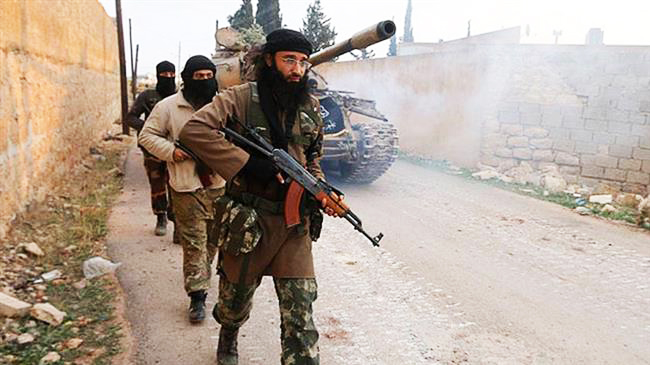
SYRIA’S permanent representative to the United Nations, Bashar al-Jaafari, said on Thursday that the United Nations’ bodies and some of its member states adopt the wrong approach in implementing the UN Security Council resolutions on combating terrorism.
That came in a press release entitled ‘Death targets innocent civilians in Damascus on the eve of Mother’s Day’, distributed by Syria’s Permanent Mission to member states and media correspondents at the United Nations about targeting the public market of Kashkoul al-Amara neighbourhood and other areas of Damascus with rocket shells.
‘The city of Damascus and other Syrian cities have been living for seven years, a daily nightmare of random death and destruction,’ al-Jaafari said. He cited the unbearable escalation of these attacks by the armed terrorist groups backed by governments of certain countries, heading the list of which are the United States, Britain, France, Saudi Arabia, Qatar and Turkey, which brand these terrorist groups as ‘moderate armed opposition’.
He said that this systematic behaviour of these countries’ representatives lacks a minimal sense of human empathy, and their policies are definitely devoid of any moral sense, let alone any sense of respect for international law and international humanitarian law. The Permanent Envoy stressed that it is time for all at the United Nations and the international community to upgrade to the level of their responsibilities and consider the real suffering of the Syrians due to the crimes of these armed terrorist groups.
On Wednesday, the terrorist gangs targeted with rocket shells the densely populated Kashkoul neighbourhood in Jaramana area, Damascus Countryside, al-Amara neighbourhood and other areas of Damascus, leaving 44 martyrs and injuring scores others.
On Thursday, terrorist organisations targeted Damascus neighbourhoods with 16 rocket shells, causing the martyrdom and injury of several civilians. A source at Damascus Police Command said the terrorist organisations positioned in Eastern Ghouta fired three rocket shells on Barzeh district, claiming the lives of two civilians, injuring four others, and causing massive material damage to a number of houses.
The terrorist organisations also fired 13 rocket shells fell on residential neighbourhoods in Damascus.
Two civilians were martyred and nine others injured, the source added. Material damage was caused and fire erupted due to the shells in Arnous, Khalid Ibn al-Walid Street, al-Bahsah and al-Marjeh where Damascus Fire Brigade put out the fire, the source said.
Meanwhile, units of the Syrian Arab Army on Thursday secured the exit of hundreds of civilians held by the terrorist organisations at the northern part of Eastern Ghouta in Damascus countryside through the safe corridor leading to al-Wafedeen camp. A SANA reporter said that over 6,000 civilians, mostly women and children who were held by the terrorist organisations in Eastern Ghouta arrived at the last point of al-Wafedenn camp corridor, where the army units provided them with their needs.
The army units, in cooperation with the Syrian Arab Red Crescent (SARC), transported them to al-Faihaa Hall in Damascus. A number of evacuated civilians said that hundreds of families inside Ghouta are still besieged and trying to leave, as the terrorist organisations use them as hostages and human shields. The correspondent added that scores of families have exited across Hamouriya corridor where army units and SARC personnel received them and provided their needs and basic materials.
This came as Syrian forces continued their drive to rid Eastern Ghouta of terrorists.
Units of the Syrian Arab Army on Thursday recaptured Ein Tarma Valley in the Eastern Ghouta area in Damascus Countryside. SANA’s correspondent in Eastern Ghouta said that the army units operating in the direction of Ein Tarma in the southern sector of Ghouta carried out, over the past hours, intensive operations in Ein Tarma area, regaining full control over Ein Tarma Valley after defeating terrorist organisations in it.
The military operations are currently concentrated on the outskirts of Ein Tarma, where the Syrian Arab Army is using tactics and weapons commensurate with the residential areas in order to protect the lives of civilians and their properties, according to the correspondent. The terrorist organisations suffered heavy losses as a result of the rapid advance of the army in the area.
Army units launched swift and precise operations in the Valley in order to serve as a stepping stone for liberating the areas of Zamalka, Hazza, Erbin and parts of Jobar neighbourhood from terrorists.
According to information, about 1,500 terrorists and 6,000 persons of their families would exit from Harasta in two batches, the SANA reporter said on Thursday.
The reporter added that a convoy of vehicles of the Syrian Arab Red Crescent and buses entered the secondary school roundabout in Harasta in preparation for transporting the militants and their families from the city. The Syrian Arab Army on Thursday managed to free 13 abductees who were held inside Harasta city on the outskirts of Eastern Ghouta in Damascus Countryside. SANA’s reporter said that the abductees were transported to the hospital to receive the necessary medical services.
A military source told SANA that 2,000 persons, including about 600 terrorists, are expected to exit from Harasta on Thursday by 40 buses and be transported to Idlib, adding that the evacuation process of the rest of the militants and their families is to be resumed on Friday. A number of vehicles and buses have entered the city of Harasta under the supervision of the Syrian Arab Red Crescent (SARC) to transport the first batch of terrorists and their families, the reporter said, adding that 16 buses carrying 1,288 persons, including 357 men, 270 women, 418 children and 243 terrorists assembled in preparation for the evacuation to Idlib.
The reporter disclosed information that an agreement has been reached for transporting 1,500 terrorists and some 6,000 persons of their families in two batches towards Idlib province, indicating that competent authorities will enter the city in order to rehabilitate it and pave the way for the return of all state institutions. Information about a number of bodies and a map of Harasta’s tunnels will be provided, according to special sources.